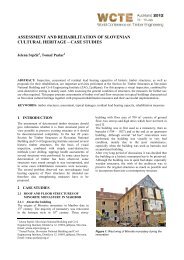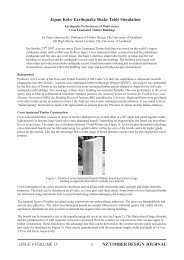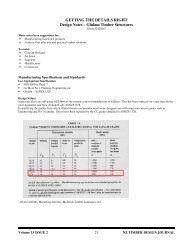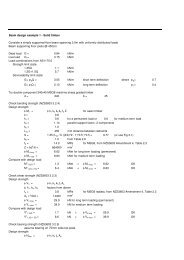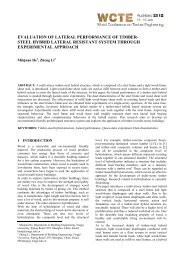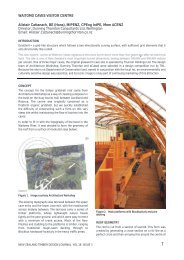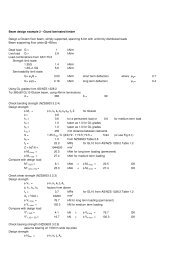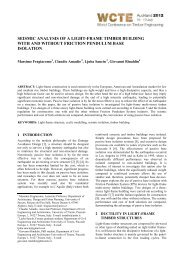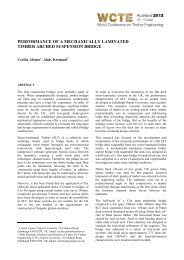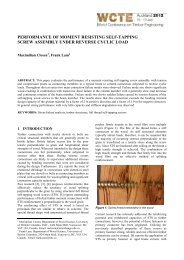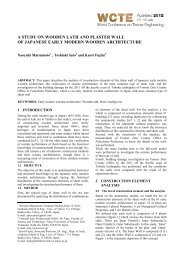HARDBOARD WEBBED WOOD I-BEAMS - Timber Design Society
HARDBOARD WEBBED WOOD I-BEAMS - Timber Design Society
HARDBOARD WEBBED WOOD I-BEAMS - Timber Design Society
Create successful ePaper yourself
Turn your PDF publications into a flip-book with our unique Google optimized e-Paper software.
<strong>HARDBOARD</strong> <strong>WEBBED</strong> <strong>WOOD</strong> I-<strong>BEAMS</strong><br />
Maya Fitton, Bryan Walford<br />
Forest Research Institute, Rotorua, New Zealand<br />
Abstract<br />
This present paper describes the testing of hardboard webbed wood I-beams with flanges of laminated veneer<br />
lumber (LVL) and analyses their performance under third-point bending. The investigations are part of an<br />
ongoing Master’s Degree study supported by Forest Research. The results showed that I-beams with<br />
hardboard webs were stronger and stiffer than the plywood webbed I-beams, in spite of the plywood webs being<br />
50% thicker than the hardboard webs.<br />
Introduction and literature review<br />
Currently in New Zealand there is only one locally manufactured I-beam - Twinaplate (with kiln dried, boric<br />
treated radiata timber flanges and corrugated steel webs) and one imported from CHH Wood Products,<br />
Australia (with LVL flanges and plywood webs).<br />
Hardboard has been used as a web material in built-up beams in Europe since the mid-1930s. Research on<br />
hardboard as a shear-web material has been done in at least six countries (McNatt, 1980): Australia,<br />
Czechoslovakia, England, Germany, Sweden, and the United States. Test data on hardboard webbed I-beams<br />
showed a good correlation with theoretical predictions for deflection and bending strength (Hilson and Rodd,<br />
1979).<br />
McNatt and Superfesky (1983) report that I-beams with hardboard webs and LVL flanges give satisfactory<br />
performance after 5 years service in an exterior or interior environment. They also compared hardboard<br />
webbed I-beams with plywood webbed I-beams. They showed that for beams loaded to the same web shear<br />
stress, those with hardboard webs deflected less than those with plywood webs. The hardboard was stiffer by<br />
three to four times in shear through the thickness than the plywood for the plywood grain orientation used.<br />
In Sweden, hardboard webs are more economical than plywood webs (Norlin, 1988). He also reports that shear<br />
strength properties of hardboard are comparable to those of plywood. He studied the behaviour of very slender<br />
webs (35
only sheet material in New Zealand with properties defined in published engineering design codes (NZS<br />
3603:1993-Code of practice for timber design).<br />
Modulus of rigidity and shear strength<br />
Modulus of rigidity (G) and shear strength (V R ) of the panels used for wood I-beam webs were determined<br />
following the procedure specified in Large Panel-Shear Test, ASTM D 2719-1994 (Britton and Fitton, 1998).<br />
This test method is regarded as giving the most accurate measure of modulus of rigidity and is recommended<br />
for elastic test of materials to be used in stress analysis studies of structures. Two specimens of each material<br />
were prepared. Density at test for each of the panel materials was calculated after mechanical testing was<br />
completed. Table 1 presents the mean strength properties and density for each material. The strength values<br />
are applicable to short term loading. For other load durations, modification factors should be used. BS<br />
5268:Part 2:1991 (Section 5) gives useful recommendations on the use of tempered hardboard for structural<br />
purposes, including suitable load duration factors.<br />
Table 1. Results from panel testing<br />
Web Tempered hardboard Plywood<br />
Density at test<br />
963 496<br />
(kg/m 3 )<br />
Modulus of rigidity G av 1944 460<br />
(MPa)<br />
Shear strength V R<br />
(MPa)<br />
7.34 4.41<br />
The observed modes of failure during the panel shear tests were as follows:<br />
• Hardboard - the specimens failed suddenly and catastrophically, shattering into several pieces.<br />
• Plywood - the material did not fail catastrophically at maximum load and showed no obvious signs of<br />
failure.<br />
The characteristic values of modulus of rigidity and shear strength for F11 grade plywood are given in AS<br />
1720.1-1997 (section 5):<br />
• modulus of rigidity - 525 (MPa),<br />
• shear strength - 5.3 (MPa).<br />
It can be seen that the values in table 1 are below the characteristic values for F11 grade plywood. The values<br />
obtained by the shear test (table 1) are closer to those for:<br />
• F8 grade for modulus of rigidity,<br />
• F7 grade for shear strength (see table 5.1, AS 1720.1-1997).<br />
The likely reason for these discrepancies is that the veneer quality from the current crop of young trees is less<br />
than that on which the characteristic stresses were established.<br />
Flange material<br />
Laminated veneer lumber<br />
LVL is an engineered wood composite material produced from rotary peeled veneers, glued and assembled<br />
together so that the grain direction of the outer veneers and most of the other veneers, is in the longitudinal<br />
direction. Typically LVL is made from of 3 mm thick veneers. Hyspan, which will soon be available in New<br />
Zealand, has thicknesses of 45 or 63 mm with widths of 170 to 600 mm (see article in Issue 1 volume 7, NZ<br />
TDJ). CHH Wood Products is the only producer of LVL and I-beams in Australia. LVL is suitable for wood I-<br />
beam flanges because it has relatively low weight, it is uniform, stronger than dimension timber, and is reliable -<br />
factors which impact on the final design cost of the beams. For the wood I-beams in this study, LVL imported<br />
from Australia in 1989 was used. Table 2 shows the characteristic stresses for Hyspan.<br />
ISSUE 3 VOLUME 7 4 NZ TIMBER DESIGN JOURNAL
Table 2. Characteristic stresses for Hyspan (MPa). Source: CHH Engineered Wood Products,<br />
Australia, 1998.<br />
Bending Tension Compression Shear Modulus of<br />
elasticity<br />
Modulus of<br />
rigidity<br />
42 27 34 4.5 13200 650<br />
The modulus of elasticity of the flanges was determined from bending tests over a span of 4.2 m under thirdpoint<br />
loading. The average value of modulus of elasticity of the two (top and bottom) flanges is given in table 3<br />
and was used for the beam calculations.<br />
Table 3. Results from testing of modulus of elasticity of LVL<br />
Beam code Web E<br />
L=5.9m L=3.9m (GPa)<br />
A1 300 K1 300 plywood 13.75<br />
A2 300 K2 300 plywood 13.75<br />
C1 300 L1 300 hardboard 16.15<br />
C2 300 L2 300 hardboard 15.85<br />
Average modulus of elasticity 14.9<br />
The shaded cells of table 3 show that the average modulus of elasticity of the tested LVL is higher than the<br />
published value by 13% (table 2).<br />
Adhesive<br />
The joints of the wood I-beams (web-web and web-to-flange joints) were made using epoxy resin HPR5. HPR5<br />
is a new generation adhesive which consists of a turbid liquid resin (part A) and a clear liquid curing agent (part<br />
B) mixed in a given ratio. Table 4 presents some of the typical cured properties of HPR5.<br />
Table 4. Typical average cured properties of HPR5 (MPa). Source: Adhesive Technologies Ltd. Auckland<br />
Tensile lap shear<br />
@ -55ºC<br />
Tensile lap shear<br />
@ 25ºC<br />
Tensile lap shear<br />
@ 50ºC<br />
Tensile strength<br />
(room temperature)<br />
Flexural strength<br />
(room temperature)<br />
29.6 29 6.9 55.8 89.6<br />
Construction of the beams<br />
The beams are described in figure 1.<br />
Figure 1. Cross-section of the I-beams<br />
Wood I-beams with codes A1 300, A2 300, C1 300 and C2 300 failed at shear between the load point and the<br />
support. Because the remaining portions of those beams were intact, they were cut down to 4 m after testing<br />
ISSUE 3 VOLUME 7 5 NZ TIMBER DESIGN JOURNAL
and retested at a span of 3.9 m. The shorter span beams were given new codes - K1 300, K2 300, L1 300 and<br />
L2 300 (table 5).<br />
Table 5. Description of the wood I-beams<br />
Beam<br />
code<br />
Web t<br />
(mm)<br />
B<br />
(mm)<br />
I x<br />
(mm 4 )<br />
Z<br />
(mm 3 )<br />
Web<br />
stiffeners<br />
Buckling<br />
restraints<br />
A1 300 plywood 9 63 118792832 791952 no 4 @ 1200 mm<br />
A2 300 plywood 9 63 118792832 791952 no 4 @ 1200 mm<br />
C1 300 hardboard 6 63 118723374 791489 no 4 @ 1200 mm<br />
C2 300 hardboard 6 63 118723374 791489 no 4 @ 1200 mm<br />
K1 300 plywood 9 36 69895886 465973 at supports 3 @ 1000 mm<br />
K2 300 plywood 9 36 69895886 465973 at supports 3 @ 1000 mm<br />
and at loads<br />
L1 300 hardboard 6 36 69826428 465510 at supports 3 @ 1000 mm<br />
L2 300 hardboard 6 36 69826428 465510 at supports<br />
and at loads<br />
3 @ 1000 mm<br />
Section properties were calculated from the following expressions:<br />
I x = the total net moment of inertia (second moment of area) about X-X axis, which was calculated<br />
without using a transformed section analysis.<br />
4<br />
Ix = Iw + I fl (mm )<br />
(1)<br />
I w = the net moment of inertia of the web<br />
3<br />
t eff (D− 2T + 2d)<br />
I w =<br />
(2)<br />
12<br />
For the computation of bending stress of plywood webbed wood I-beams, the net moment of inertia is based on<br />
parallel plies plus 0.03 times plies perpendicular to the span (AS 1720.1-1997, section 5, table 5.4 and<br />
Appendix J).<br />
t eff = 6 + 0.03 x 3 = 6.09 (mm) (3)<br />
I fl = the net moment of inertia of the flange<br />
3 3<br />
B[D − (D−<br />
2T) ]<br />
I fl =<br />
(4)<br />
12<br />
Z = the section modulus (a geometrical property of the beam)<br />
2I x<br />
Z =<br />
D (mm3 ) (5)<br />
Flange-to-web joints<br />
The flange-to-web joint was a square-edged web glued into routed groove (slot).<br />
Web-web joint<br />
The web ends were butt jointed. Splice plates were centred and glued over the full contact area without staples.<br />
The splice plates were made of the same material as the webs with lengths twelve times the panel thickness. A<br />
gap of about 6 mm was left between the plates and the flanges.<br />
Web stiffeners<br />
Web stiffeners were cut from plywood with thickness 18 mm and width 50 mm. The arrangement can be seen<br />
from table 5. A gap of about 3 mm was left between the web stiffener and the compression flange at bearing<br />
ends and between the web stiffener and the tension flange at load points. The other end of the web stiffener was<br />
installed in tight contact with the bottom or top flange. The gap prevents the web stiffener from pushing the<br />
flanges apart when the bending deflection is large (Leichti et al., 1990).<br />
ISSUE 3 VOLUME 7 6 NZ TIMBER DESIGN JOURNAL
<strong>Design</strong> method<br />
Deflection formulas<br />
The deflection of a wood I-beam is taken as a sum of the calculated deflections due to bending and to shear.<br />
This can be expressed as:<br />
∆ = ∆b + ∆s ( mm) (6)<br />
where<br />
PL<br />
∆ b = 23<br />
1296EIx<br />
(mm) (7)<br />
∆ = total deflection<br />
∆ b = bending deflection<br />
P = total load<br />
L = span<br />
E = modulus of elasticity of the flange material ( table 3).<br />
Shear deflection was calculated using APA, supplement 2, formula.<br />
and ∆ KPL<br />
s<br />
6G wA (8)<br />
∆ s = shear deflection<br />
A = cross-sectional area of the beam<br />
A = 2(BxT) + t(D-2T) (mm 2 ) (9)<br />
G w = modulus of rigidity of the web (table 1).<br />
K = factor determined by the beam cross-section and is given below:<br />
3<br />
K =<br />
9<br />
2<br />
5<br />
5<br />
1 <br />
1 s<br />
1 3 2 1 2 8<br />
( 1<br />
3 s <br />
5 3<br />
s 8s<br />
− s)<br />
+ s 2 − s + s<br />
s<br />
p p 2 2 <br />
+ <br />
p<br />
− <br />
30<br />
+ <br />
<br />
+ + − +<br />
<br />
3<br />
3 3<br />
2 30 +<br />
<br />
<br />
<br />
β β β β 30<br />
<br />
( s )<br />
1 1<br />
3 3<br />
− + s <br />
p <br />
2<br />
(10)<br />
β = G fl.<br />
G w<br />
p = t B<br />
s = D - 2T<br />
D<br />
G fl = modulus of rigidity of the flange (table 2)<br />
(11)<br />
(12)<br />
(13)<br />
The other notations are shown in figure 1.<br />
Table 6 summarises the factor ‘K’ for the I-beams:<br />
Table 6. Section factor, K.<br />
Beam code K<br />
A1 300, A2 300 3.29<br />
C1 300, C2 300 4.84<br />
K1 300, K2 300 2.19<br />
L1 300, L2 300 3.18<br />
The expected stiffness of the beam, P , is calculated from equations 6, 7 and 8:<br />
∆<br />
P<br />
∆ = 1<br />
3<br />
(kN / mm) (14)<br />
23L<br />
KL<br />
+<br />
1296EI<br />
6G A<br />
x<br />
w<br />
ISSUE 3 VOLUME 7 7 NZ TIMBER DESIGN JOURNAL
Bending test arrangements<br />
Third point bending tests on the beams were carried out on the laboratory strong-floor at Forest Research. The<br />
beams were loaded upwards and were restrained at their ends by attachments connected to the strong-floor.<br />
Figure 2 shows the arrangement of the testing equipment. Total specimen deflection was measured below the<br />
beam at mid-point and recorded as a load/deflection curve on a x-y plotter. Buckling restraints were provided<br />
at appropriate intervals along the span (see table 5). The rate of loading of the beams was such that failure<br />
would be achieved in 3 to 5 minutes.<br />
Restraint Equipment Attached to Laboratory Strong-floor<br />
Load Reaction<br />
Point<br />
Test Beam<br />
Loading Head<br />
Load Cell<br />
LVDT<br />
Jack<br />
Hydraulic pump<br />
Plotter recording Load / Total Deflection<br />
X Y Plotter<br />
X<br />
Y<br />
Figure 2. Third-point loading arrangement<br />
Wood I-beams failure modes<br />
I-beams with span 5.9 m<br />
a) Plywood webbed wood I-beams<br />
The webs of the two I-beams buckled at the end reaction. The beams failed near the tension flange by web<br />
crushing (figure 3). It was assumed that the web buckling and crushing was caused by a lack of vertical<br />
stiffeners at the supports.<br />
b) Hardboard webbed wood I-beams<br />
The I-beams failed explosively in shear breaking the web into several pieces (figure 4) between one of the load<br />
points and the end of the beam. The cracks ran at a slope of about 45º. The difference in the failure modes<br />
between C1 300 and C2 300 was that the web of C2 300 buckled at one of the end reactions. The reason is that<br />
the beam was not supplied with vertical stiffeners at support to prevent the buckling.<br />
ISSUE 3 VOLUME 7 8 NZ TIMBER DESIGN JOURNAL
Figure 3. Beam A1 300. Web crushing near the tension flange.<br />
Figure 4. Beam C1 300. Hardboard web failure.<br />
I-beams with span 3.9 m<br />
a) Plywood webbed wood I-beams<br />
The compression flanges of the two I-beams buckled sideways between the load points. The sideway buckling<br />
of the beams caused adjacent buckling of the web without any web-web or web-to-flange joints failure. Further<br />
load increase caused an ‘S’ curve to develop in the beams and a significant end rotation at reaction points<br />
(figure 5). Beam K1 300 failed by buckling of the compression flange while the web of beam K2 300 crushed<br />
near the compression flange as can be seen from figure 6. It is believed that the significant end rotation and the<br />
ISSUE 3 VOLUME 7 9 NZ TIMBER DESIGN JOURNAL
uckling of beam K2 300 caused the web crushing (see figure 6). It was observed that the gap left between the<br />
stiffener at the end of the beam K2 300 and the compression flange was bigger than normally specified by most<br />
of the manufacturers (about 3 mm) and the web crushing continued through the gap.<br />
b) Hardboard webbed wood I-beams<br />
The two I-beams presented a typical shear failure located between one of the load points and the end reaction of<br />
the beam (figure 7). The web failure did not cause web-to-flange failure or pulling out the stiffeners. The<br />
compression flange of the beam L2 300 buckled between one of the supporting ends and the lateral restraint<br />
The failure modes of the wood I-beams with plywood and hardboard webs (span 3.9 m) suggests that an<br />
additional lateral support was required - a fully restrained compression flange and a lateral support at bearings<br />
to prevent rotation and displacement. In practice buckling of I-beams supporting flooring is not a problem as<br />
the compression (the top) flange is fully restrained.<br />
The results showed good bonding for all the beams as there were no failures in the web-to-flange or in the webweb<br />
joints.<br />
Figure 5. Beam K1 300. The figure shows the beam buckling and end rotation.<br />
ISSUE 3 VOLUME 7 10 NZ TIMBER DESIGN JOURNAL
Figure 6. Beam K2 300. End rotation and buckling.<br />
Figure 7. Beam L1 300. Shear failure between end reaction and load point.<br />
ISSUE 3 VOLUME 7 11 NZ TIMBER DESIGN JOURNAL
Results and discussion<br />
Table 7 summarises the experimental and design data of the wood I-beams. The shaded cells show the ratio of<br />
the observed properties of the I-beams and their design values. The results were in good agreement with the<br />
design data. The ratios of observed to expected properties ranged from 0.84 to 1.54 with an average of 1.10.<br />
The critical failure values (the beams failed in shear or buckling) are indicated in bold.<br />
Table 7. Summary of experimental and design data.<br />
Beam P ult<br />
Stiffness P ∆ (kN/mm) Strength of flanges<br />
(MPa)<br />
Shear strength<br />
(N)<br />
code (kN) Expected Observed Obs./<br />
exp<br />
F t F obs F obs / F t V R V obs V obs /<br />
V R<br />
A1 300 19.2 0.3365 0.3933 1.17 27 23.8 0.88 4.41 4.35 0.99<br />
A2 300 18.2 0.3365 0.3746 1.11 27 22.6 0.84 4.41 4.13 0.94<br />
C1 300 26.0 0.4601 0.5063 1.10 27 32.3 1.20 7.34 8.95 1.22<br />
C2 300 22.8 0.4526 0.5049 1.12 27 28.3 1.05 7.34 7.85 1.07<br />
K1 300 20.0 0.6240 0.6588 1.06 27 27.9 1.03 4.41 4.50 1.02<br />
K2 300 17.9 0.6240 0.6701 1.07 27 25.0 0.93 4.41 4.03 0.91<br />
L1 300 29.9 0.8896 0.9831 1.11 27 41.7 1.54 7.34 10.3 1.41<br />
L2 300 24.7 0.8759 1.0686 1.22 27 34.5 1.28 7.34 8.52 1.16<br />
1.12 1.09 1.09<br />
Comparison of the average values for hardboard and plywood webbed wood I-beams<br />
(1) 25.85 0.67 0.77 1.14 34.2 1.27 7.34 8.90 1.21<br />
(2) 18.82 0.48 0.52 1.10 24.8 0.92 4.41 4.25 0.96<br />
(1)/(2) 1.37 1.40 1.48 1.38 1.66 2.09<br />
(1) = average value for hardboard webbed wood I-beams (C 300+L 300)<br />
(2) = average value for plywood webbed wood I-beams (A 300+K 300)<br />
In table 7 the following formulas and definitions apply:<br />
P ult = ultimate load<br />
P<br />
is from equation (14)<br />
∆<br />
F t = characteristic stress in tension for LVL (table 2)<br />
F obs = observed modulus of rupture<br />
F<br />
Pult<br />
L<br />
= (MPa)<br />
(15)<br />
obs<br />
6Z<br />
Z is from equation (5)<br />
V R = strength in shear (table 1)<br />
V obs = observed shear stress in web<br />
Pult.<br />
Q<br />
Vobs<br />
= (N)<br />
2tI x<br />
(16)<br />
For I x see equations (1), (2) and (4).<br />
Q = statical moment (first area moment)<br />
Q = Qw<br />
+ Qfl<br />
(mm 3 ) (17)<br />
Q w = statical moment of the web<br />
2<br />
(D− 2T + 2d)<br />
Q = t x (18)<br />
w<br />
eff<br />
8<br />
t eff is from equation (3)<br />
Q fl = statical moment of the flanges<br />
Q A x D − T<br />
fl = fl<br />
(19)<br />
2<br />
A fl = net flange area (all web material removed). Table 8 shows the net flange areas of the beams.<br />
ISSUE 3 VOLUME 7 12 NZ TIMBER DESIGN JOURNAL
Stiffness<br />
Table 8. Net flange area of the beams.<br />
Beam code Net flange area A fl<br />
(mm 2 )<br />
A1 300, A2 300 3807<br />
C1 300, C2 300 3861<br />
K1 300, K2 300 2106<br />
L1 300, L2 300 2160<br />
The average observed stiffness of the beams, as a ratio of load to deflection, was higher than the expected<br />
stiffness by 12%. There was a good agreement (see the last row of table 7) between the expected difference in<br />
stiffness of hardboard and plywood webbed I-beams (ratio of 1.4) and the observed difference in stiffness (ratio<br />
of 1.48). The fact that the hardboard webbed I-beams were stiffer than those with plywood webs is thought to<br />
be due to two main effects:<br />
• The higher stiffness of the flanges used for hardboard webbed I-beams<br />
As can be seen from table 3 the difference in the flange stiffness is 16%. The influence of flange stiffness on<br />
the load capacity was investigated by different authors. For example, Samson (1983) showed that more than<br />
50% of the variation in load-carrying capacity of I-beams is due to the variation of the tension flange. He<br />
compared the load capacity in flexure of 100 double-web I-beams with flanges of three lumber laminations and<br />
waferboard webs. He found that the maximum load was correlated linearly to the average stiffness of the<br />
tension flange laminations.<br />
• The web material<br />
Leichti et al. (1990) found that the web material had a significant effect on I-beam stiffness and load capacity.<br />
Superfesky and Remaker (1978) investigated 6.4 mm hardboard and 6.4 mm plywood webbed I- beams under<br />
short-term destruction loading. They reported that the strength and stiffness of plywood webbed I-beams was<br />
about half that of the hardboard webbed beams.<br />
Bending strength<br />
The average ratio of observed bending strength to expected characteristic strength was 1.09. Hardboard<br />
webbed I-beams were stronger than plywood webbed I-beams by 38%. As can be seen from the last rows of<br />
table 7 the observed bending strength of hardboard webbed I-beams was higher than the expected flange stress<br />
by 27% while for the plywood webbed I-beams the bending strength was lower by 8%. This lower value,<br />
however, did not cause failure in bending.<br />
Shear strength<br />
The ratio of design shear strength of hardboard to shear strength of plywood was 1.66 while the observed<br />
average ratio was 2.09. The average shear strength of plywood (4.25 MPa) was lower than the theoretical by<br />
3.6%. This tends to show that the short term shear strength value for F11 plywood is probably close to the<br />
observed value. On the other hand the good shear strength of hardboard indicates that probably the average<br />
value derived from the panel shear test underestimates the panel properties.<br />
Conclusions<br />
The conclusions below are based on short-term third point loading of four hardboard webbed wood I-beams and<br />
four plywood webbed I-beams.<br />
• Thin oil tempered hardboard manufactured in New Zealand performs well compared to plywood.<br />
• The shear strength was higher for hardboard than for plywood in spite of its thinner dimension.<br />
• Hardboard has potential as a web material in manufacturing wood I-beams. However, further study is<br />
required due to the limited test data.<br />
ISSUE 3 VOLUME 7 13 NZ TIMBER DESIGN JOURNAL
References<br />
American Plywood Association (APA), 1982: Supplement 2, <strong>Design</strong> and fabrication of plywood-lumber<br />
beams. American Plywood Association, Tacoma, WA.<br />
BS 5268 : 1991: Structural use of timber, Part 2: Code of practice for permissible stress design, materials and<br />
workmanship. British Standards Institute, London.<br />
Britton, R.A.J., and Fitton, M., 1998: Large panel-shear tests on four wood-based panel materials. New<br />
Zealand Forest Research Institute Ltd, Project Record No 6232, (unpublished)<br />
Hilson, B.O., and Rodd, P.D., 1979: The ultimate shearing strength of timber I-beams with hardboard webs.<br />
The Structural Engineer 57B (2):25-36.<br />
Leichti, R.J., Falk, R.H., Laufenberg, T.L., 1990: Prefabricated wood I-beams: a literature review. Wood and<br />
Fiber Science. Vol. 22, No.1, pp. 62-79.<br />
McNatt, J.D., 1980: Hardboard webbed beams: research and application. Forest Products Journal, Vol. 30,<br />
No. 10, pp. 57-64.<br />
McNatt, J.D., and Superfesky, M.J., 1983: Long-term load performance of hardboard I-beams. United States<br />
Department of Agriculture, Forest Service, Forest Products Laboratory, Research Paper FPL 441.<br />
Norlin, B., 1988: Buckling of hardboard-webbed I-beams. Proceedings of the International Conference on<br />
<strong>Timber</strong> Engineering, Seattle, Washington, USA. Vol.1, pp. 602-617.<br />
Samson, M., 1983: Influence of flange quality on the load-carrying capacity of composite webbed I-beams in<br />
flexure. Forest Products Journal, Vol. 33, No.1, pp. 38-40.<br />
Superfesky, M.J., and Ramaker, T.J., 1978: Hardboard-webbed I-beams: long-term loading and loading<br />
environment. USDA Forest Service Research Paper, FPL 306. Forest Products Laboratory, Madison, WI,14<br />
pp.<br />
Acknowledgment<br />
The authors acknowledge the special assistance of Mr Bruce Davy and Mr Bob Britton during the pressing and<br />
testing of the I-beams.<br />
ISSUE 3 VOLUME 7 14 NZ TIMBER DESIGN JOURNAL



